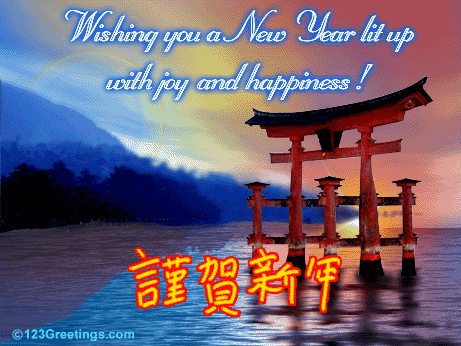Oshogatsu, or Shogatsu, is Japan's biggest celebration, and as a result has too much to it for me to type here. So, I'll just break it up into the biggest and basic parts and just give some brief details.
You can just skip to the section that interests you:
- Omisoka
- Food
- Postards/Greeting Cards (Nengajo)
- Dreams
- Games
- Other info
- Pics :D
1.) Omisoka - New Year's Eve:
This is the second most important day to the Japanese, because it's the last day of the year. Purification and being clean is a big part of Japanese custom, so on this last day of the year, people clean thier house rather thoroughly. They even have to change the shoji (see first pic).
Many specials are aired on TV, and families gather around to eat and prepare all the food for New Years Day! Also, just before midnight, Buddhist Temples ring their bells 108 times to send out the old year and bring in the new
2.) Food:
Food is a big part of the Japanese New Year (and when I say New Year, note that I am refering to the first seven days (for Shinto belief) or the first three days (for everyone else) of January). There's Ozoni (or Zoni, a kind of stew; see fourth pic), mochi (which are Japanese rice cakes; see fifth and sixth pics), kamaboko (fish paste; see seventh pic), kurikinton (mashed potato with chestnut; see eighth pic), and kuromame (sweet black beans). And, on the last day of it all, Nanakusa gayu is prepared (seven vegetable rice soup; see ninth pic).
3.) Postcards:
The custom is to send nengajo, or New Years Postcards, to family and friends. As long as they say nengajo, the post office will deliver them on he first of January! And, thanks to businesses who crave money, there are many different types of postcards to send - from ones based off of the Chinese Zodiac, to ones based off of Disney and different anime.
4.) Dreams:
The first dream of the New Year is major. When a Japanese person goes to sleep for the first time in the new year, he/she has only one thing on their mind: I hope I have a good dream. The first dream is suppose to be a representation of the year to come, i.e. if it is a bad dream, expect a bad year, but if it's a good dream expect a good year.
5.) Games:
Many different types of games are played (which I need wikipedia for :P), including hanetsuki (think badminton), takoage (kite flying), koma (spinning a top), sugoroku (read: Snakes and Ladders), fukuwarai (kinda like pin the tail on the donkey, only you pin parts of a face on a drawing), and many card games.
6.) Other info:
So much, so little time. There's also money giving called otoshi-dama, many good luck charms like cranes and kame (turtles), and the ever important first visit to the local temple/shrine called Hatsu Mohde.
7.) Pictures:

[Traditional Japanese sliding door with Shoji (or the paper)]

[Shrine on Omisoka, or New Year's Eve]

[Shrine on Omisoka, or New Year's Eve]

[Zoni]

[Regular mochi]

[Hilo style mochi]


[Kamaboko(Left) and Kurikinton (Right)]

[Nanakusa-gayu]

[A bunch of food laid out]

[Shrine on New Year's Day]

[Good luck charms]

[Here's a "New Age" Postcard that can be sent over the internet - note this is not mine, it's from a site]
Annnnnnnnnd, that's it. Or, rather, that's all I have room for :lol:
Coming up:
~ 47 Ronin Festival
~ Sapporo Snow Festival (early Feb.)